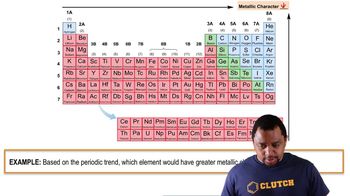Ch.22 - The Main Group Elements
Chapter 22, Problem 41
Which compound in each of the following pairs is more covalent? (a) CaO or NO (b) NH3 or KH (c) SnO2 or SiO2
 Verified step by step guidance
Verified step by step guidance1
Step 1: Understand the concept of covalent character. Covalent character in a compound is determined by the sharing of electrons between atoms. The more the electrons are shared, the more covalent the bond is. Factors such as electronegativity difference and the type of elements involved (metal vs. non-metal) influence covalent character.
Step 2: Analyze pair (a) CaO or NO. Calcium oxide (CaO) is an ionic compound formed between a metal (Ca) and a non-metal (O), while nitrogen monoxide (NO) is a covalent compound formed between two non-metals (N and O). Generally, compounds formed between non-metals are more covalent.
Step 3: Analyze pair (b) NH3 or KH. Ammonia (NH3) is a covalent compound formed between non-metals (N and H), whereas potassium hydride (KH) is an ionic compound formed between a metal (K) and a non-metal (H). Covalent bonds are typically found in compounds formed between non-metals.
Step 4: Analyze pair (c) SnO2 or SiO2. Both tin(IV) oxide (SnO2) and silicon dioxide (SiO2) are oxides, but SiO2 is known for its strong covalent network structure, while SnO2 has more ionic character due to the presence of a metal (Sn).
Step 5: Conclude by comparing the nature of the bonds in each pair. For each pair, the compound with bonds formed between non-metals or with a smaller electronegativity difference is generally more covalent.
Key Concepts
Here are the essential concepts you must grasp in order to answer the question correctly.
Covalent Character
Covalent character refers to the degree to which a bond between two atoms exhibits characteristics of covalent bonding, which involves the sharing of electron pairs. Compounds with similar electronegativities tend to form more covalent bonds, as the shared electrons are held more closely between the atoms. This concept is crucial for comparing the covalent nature of different compounds.
Recommended video:
Guided course

Metallic Character Example
Electronegativity
Electronegativity is a measure of an atom's ability to attract and hold onto electrons in a bond. The difference in electronegativity between two bonded atoms can indicate the type of bond formed: a small difference suggests a covalent bond, while a large difference indicates an ionic bond. Understanding electronegativity helps in predicting which compound in a pair is more covalent.
Recommended video:
Guided course

Electronegativity Trends
Ionic vs. Covalent Bonds
Ionic bonds form between atoms with a significant difference in electronegativity, leading to the transfer of electrons and the formation of charged ions. In contrast, covalent bonds form when atoms share electrons more equally. Recognizing the nature of the bonds in the compounds being compared is essential for determining which is more covalent.
Recommended video:
Guided course

Chemical Bonds Example 1
Related Practice
